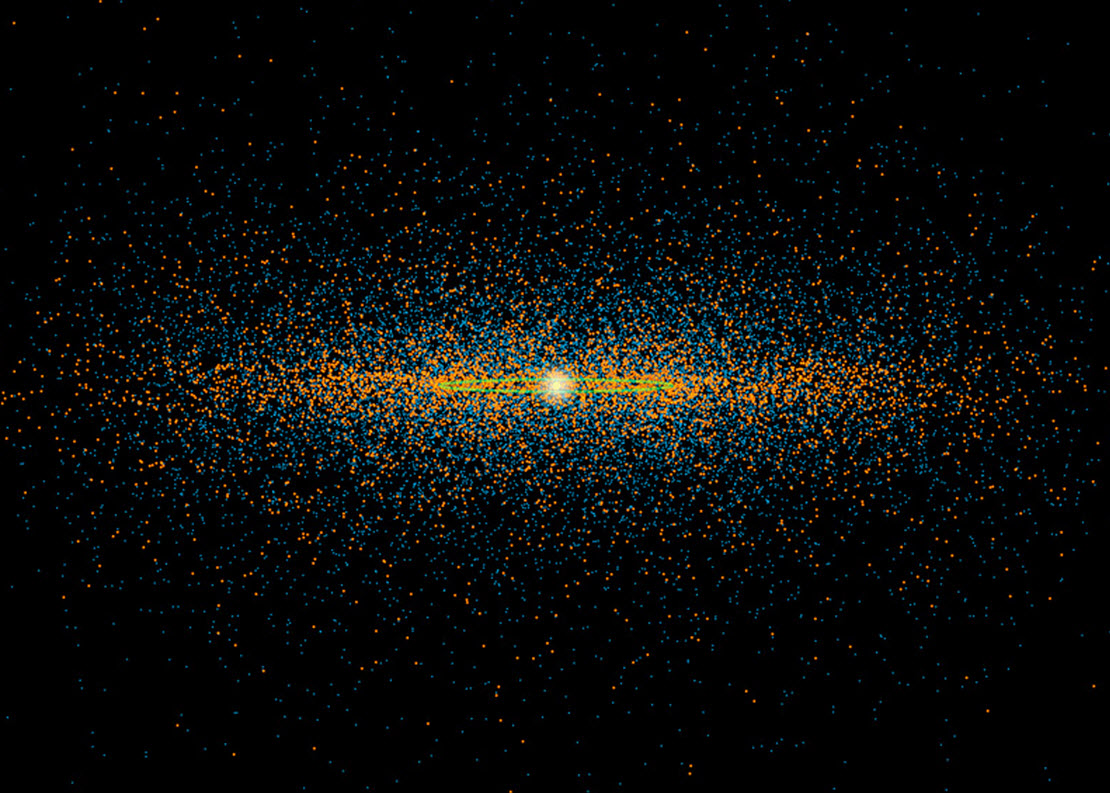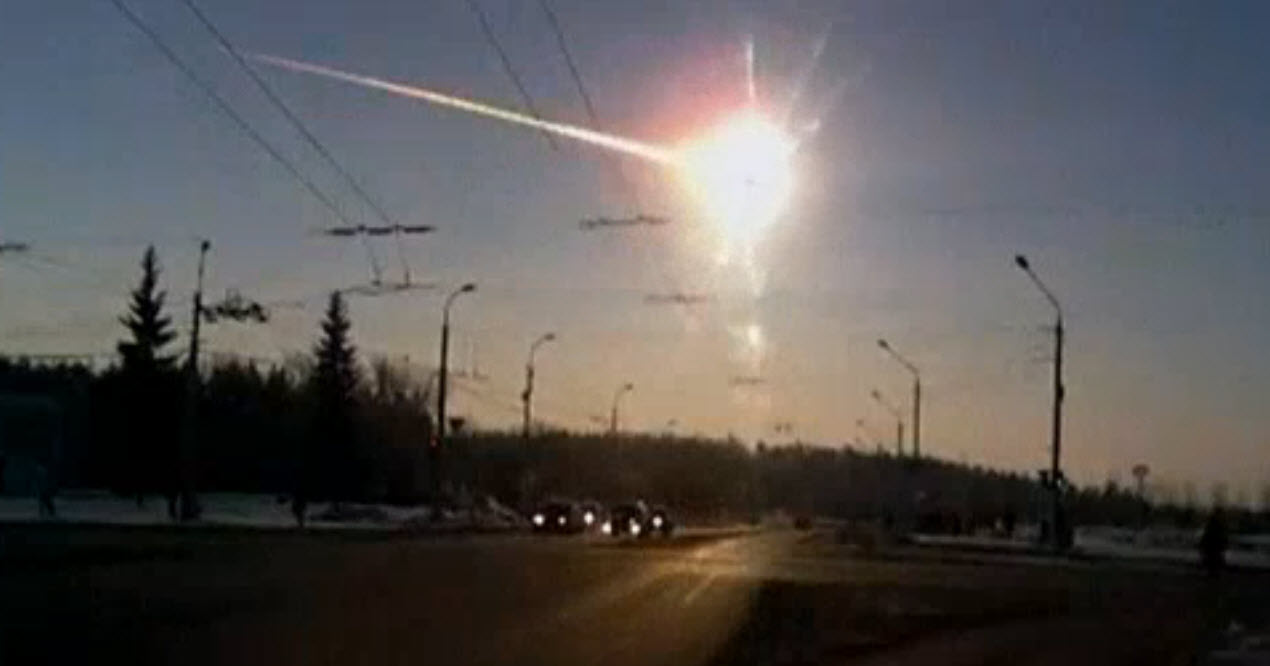It’s time for a real policy on asteroids
February 24, 2013 by Peter A. Garretson

Edge-on view of our solar system with Sun (white) in the center, showing the population of near-Earth asteroids (NEAs) and potentially hazardous asteroids (PHAs) that scientists think are likely to exist based on the NEOWISE survey. Positions of a simulated population of PHAs on a typical day are shown in bright orange, and the simulated NEAs are blue. Earth’s orbit is green. (Credit: NASA/JPL-Caltech)
If you think the events of the post-Valentine’s day surprise of the Russian Meteor and 2012 DA14 near miss are one of a kind, think again. “We know there are 500,000 to 1 million asteroids the size of DA14 or larger. So far we have found fewer than 1% of that ‘cosmic hailstorm’ through which we sail in our yearly orbit around the Sun,” said the Association of Space Explorers in a recent statement.
We are tracking fewer than 10,000 of them. Even our pathetically limited space situational awareness of the threat shows that there were a total of ten close approaches just this month and there are many more near-approaches on the way, including as many as 1,381 already-mapped potentially hazardous objects.
Near-Earth asteroids (NEAs) are asteroids with closest approach to the Sun (perihelion) less than about 121 million miles). So far, 9644 NEAs have been discovered, as of Feb. 22, 2013.
Potentially hazardous asteroids (PHAs) are the subset of NEAs with the closest orbits to Earth’s orbit, coming within 5 million miles (about 8 million kilometers). They are also defined as being large enough to survive passage through Earth’s atmosphere and cause damage on a regional or greater scale. The latest results provide the best count yet of the total PHA population, finding about 4,700 plus or minus 1,500 with diameters larger than 330 feet (about 100 meters). The NASA NEOWISE team estimates that about 20 to 30 percent (1,381) of the PHAs thought to exist have actually been discovered to date.
Sources: NASA Survey Counts Potentially Hazardous Asteroids, Near-Earth Asteroid Discovery Statistics, NEO Groups
A federal asteroid policy

This diagram illustrates the differences between orbits of a typical near-Earth asteroid (blue) and a potentially hazardous asteroid, or PHA (orange). PHAs are a subset of the near-Earth asteroids (NEAs). They have the closest orbits to Earth’s orbit, coming within 5 million miles (about 8 million kilometers), and they are large enough to survive passage through Earth’s atmosphere and cause damage on a regional or greater scale. (Credit: NASA/JPL-Caltech)
In 2008 some prescient members of Congress wrote HR 6063, which tasked the Director of the President’s Office of Science and Technology Policy to develop a policy for notifying federal agencies and relevant emergency response institutions of an impending near-Earth object threat, if near-term public safety is at stake.
The bill also recommended a federal agency or agencies to be responsible for protecting the nation from a near-Earth object that is anticipated to collide with Earth, and for implementing a deflection campaign, in consultation with international bodies, should one be required.
In the winter 2008 issue of Ad Astra, I argued that it would not be long before this issue was raised to presidential-level attention, given that the Association of Space Explorer’s report to the United Nations Committee on the Peaceful Uses of Outer Space had said that, as new telescopes come online, in a little over a decade we are likely to be tracking as many as 1 million near-Earth asteroids (NEAs) — of which 10,000 may have some probability of impacting Earth in the next 100 years, and 50 to 100 will appear threatening enough to require active monitoring and/or deflection.
In August 2009, in an article for The Space Review, I advised that the forthcoming national space policy should establish a lead agency and supported/supporting relationships for the now fully established asteroid/comet hazard.
And I gave my breakout of recommendations for who should be in charge of what. This was based upon my experience having conceived and executed the only official U.S. government multi-agency simulation (USAF-NASA-OSD-NSC-DOE) of how we would attempt to either deflect or do emergency response for an asteroid threat.
In 2010 the Air Force sent me on a CFR fellowship to India’s premier strategic think tank to explore “big ideas” that might advance the U.S.-India strategic partnership. I floated both Planetary Defense and Asteroid Mining as two such big ideas and argued that they should be included as topics for the Indo-U.S. civil-space dialog, as well as potential deliverables for the President’s visit to India in 2010, as responsive to the administration’s stated national interests of engaging key centers of influence and shaping a rules-based global order.
Later in 2010 I spoke to NASA on planetary defense considerations for a human mission to an asteroid, suggesting that this be a primary and not secondary objective for such a mission.
Earlier this year, in fact just prior to the dramatic announcements of Planetary Resources and Deep Space Industries, I argued in ASPJ that space strategists and policymakers needed to be thinking actively about a future space environment where commercial space industries might have capabilities to mine and exploit asteroids.
Most recently I argued for elevating the prominence of asteroid threats and opportunities in my OpEd on KurzweilAI and an interview for DoDLive.
A wakeup call

Meteor rains down on central Russia, injuring up to 1,200 people (credit: Independent/amateur video)
But look: meteors raining fire down on Russia injuring hundreds of people, and the closest pass of an asteroid ever forecast and recorded (2012 DA14) as a post-Valentine’s day surprise need to be a wakeup call. The longer we go without a proactive space policy on asteroids, the more we sacrifice international leadership, hold back our industry, and reduce our chances of being able to effectively deal with the threat.
The timing is perfect for a second Obama administration — an administration that sought a manned mission to an asteroid, and which has continued and expanded the Bush legacy of being friendly toward commercial space — to re-issue a revised national space policy that contains a real policy on Asteroids.
Such a real policy, a proactive policy — a visionary and durable policy for the decades and centuries ahead — needs to include the following elements:
1) The United States intends to lead the world in the creation of a planetary defense architecture, and shape the accompanying global regime. It will proactively engage the key centers of influence on the subject and pursue active collaboration with the friendly space powers. It will introduce discussions such as exploring necessary exceptions or modifications to the Limited Test Ban Treaty and Outer Space Treaty as may be required to protect planet Earth.
2) The United States intends to promote and incentivize asteroid mining and space industrialization. It will seek to create a global regime that is favorable to private industry generally, and that seeks to put American industry in a position to lead.
The United States will broaden the discussions of the International Code of Conduct to ensure it reflects the equities of future space development and is private-industry-friendly. The United States will welcome discussion on a revised space regime that creates property-like incentives that encourage early market entry into a new market that could so dramatically advance prospects for long-term human survival and sustainable development.
As a nation, we need to be prepared to promote “space resource utilization” (aka asteroid and lunar mining) as a strategic industry, using the same techniques we used in our westward expansion and railroad building and the development of our aviation industry. We should set as a goal that it should be an American company to mine the first asteroid, and set the precedent for a responsible and open in-space commerce system.
3) Planetary defense will be established as a formal mandate to one or more of the appropriate organizations, with a single agency responsible for developing and executing an actual asteroid deflection mission (I have elsewhere argued that this should be USSTRATCOM). This organization should be tasked with creating a roadmap to specific increments of capability, beginning with deflecting small “city-killer” 50-meter objects like 2012 DA14, and progressing to kilometer-class civilization-ending threats in difficult-to-reach inclinations.
The U.S. government will have an encouraging policy to source asteroid-related space-situational awareness from private industry.
4) Pre-competitive research enabling private industry will be given as a formal mandate to an appropriate organization (such as NASA, Dept of Commerce’s Office of Space Commercialization, or FAA’s office of space transportation).
Without a lead agency that perceives itself to have a mandate, and clear policy stating where we desire to go, we leave both our government officials and our private industry disempowered to deal with the dangers and advance the opportunities that near-Earth asteroids present.